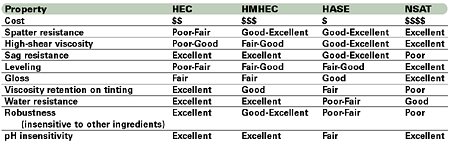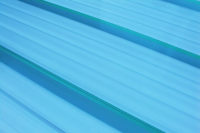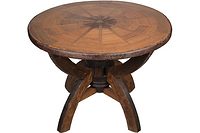
Thickener performance, especially for synthetic associative thickeners, depends on interactions with latexes and surface-active paint ingredients such as surfactants and dispersants. However, each of the four classes of organic thickeners is characterized by several attributes that are fairly independent of paint type and composition (see Table 1).
Interior Paints-Contractor Flat Paint
High-molecular-weight HEC is the product of choice for high-PVC contractor flats. In addition to being cost effective, high-molecular-weight HEC imparts low high-shear viscosity, which is recommended for effective airless spraying. HEC also gives excellent sag resistance.Paints thickened with HEC have a creamy consistency and excellent syneresis resistance — two attributes that many contractors associate with quality.
If spatter resistance is important — either because the paint is going to be backrolled after spraying or applied by roller — then HMHEC should be used. Table 2 compares HEC and HMHEC in a contractor flat formulation.
Consumer Flat Paint
Consumers expect paint to be essentially spatter-free and available in a number of colors. These two factors make HMHEC an excellent choice for the sole or primary thickener. HMHEC can be supplemented with a low-shear (LS) effective NSAT to increase film build. (See sidebar, “Which Associative Thickener?”). HASEs are an economical option for consumer flats. Paint thickened with traditional HASEs has good spatter resistance, but can have low water resistance, poor colorant compatibility, and an undesirable gel-like consistency. Some newer HASEs demonstrate improvements in colorant compatibility and consistency. Consumer flat paint data is found in Table 3.
Eggshell and Satin Paint
The properties of low-sheen paints vary widely from manufacturer to manufacturer, as do the thickeners and rheology modifiers used.A key factor in selecting thickeners for low-sheen paints is the degree of leveling required. If leveling is crucial, an NSAT is recommended as the primary thickener. Using HMHEC as a co-thickener will aid pigment dispersion (if added during the grind), sag resistance, and viscosity retention on tinting.
Table 4 illustrates the properties of a premium eggshell paint thickened with an NSAT/HMHEC package.

Semi-Gloss and Gloss Paint
In semi-gloss and gloss paints, selecting the best thickener combination is challenging. Good leveling and gloss have to be balanced against sag resistance, block resistance, and colorant compatibility.NSATs are often the primary thickeners because of their excellent leveling and gloss development. As with eggshell paints, HMHEC can be used as a co-thickener to improve sag resistance and colorant compatibility; usage levels can be as high as 25% of the total thickener package before gloss and leveling are reduced.
Figure 1 illustrates the ICI viscosity, sag resistance, and leveling of a series of 22% PVC vinyl acetate-ethylene paints thickened with a combination of HMHEC and a low-shear effective NSAT. Each paint has the same Stormer consistency and total thickener concentration. Increasing the NSAT fraction boosts leveling and ICI viscosity but decreases sag resistance.
In paints made with small particle size acrylic or styrene-acrylic latexes, high-shear effective NSATs can be the sole or primary thickener. Table 5 shows the performance of a gloss paint thickened primarily with a high-shear effective NSAT to obtain good high-shear viscosity, and co-thickened with a low-shear effective NSAT for Stormer consistency.
High-shear effective HASEs can also be the sole or primary thickener for some acrylic semi-gloss paints. Although they have relatively poor thickening efficiency and leveling, they do impart good gloss, film build, and block resistance. They also retain more viscosity after tinting than NSATs.
Exterior Paints
Exterior paints present the formulator with the additional demand of high water resistance. For this reason, nonionic thickeners — HEC, HMHEC and NSATs — predominate. Anionic HASEs can be used at low levels, but care must be taken in selecting the proper latex, base and dispersant.Flat and Low-Sheen Paint
HEC makes a cost-effective thickener for exterior house paint. Medium-molecular-weight grades, while not as efficient as high-molecular-weight types, will give higher ICI viscosity at the same Stormer consistency (see Table 6). Higher ICI viscosity gives greater film build — a key attribute for exterior paints because they serve a protective as well as a decorative role. NSATs can be used with HEC to further augment film build. HMHEC offers the advantage of improved leveling vs. HEC. Improved leveling may indirectly enhance mildew resistance: a smooth finish has few brush marks or other blemishes where dirt and spores can collect.
Semi-Gloss and Gloss Paints
Trim paints can be thickened with NSATs, often in combination with HEC or HMHEC. As with interior paint, the relative ratios depend on the gloss, leveling, and film build targets — higher levels of NSATs increase all three properties.Conclusion
Paint formulators, by drawing from the four main classes of thickeners, can assemble a thickener package to satisfy the performance requirements for each type of latex paint.Acknowledgements
Special thanks to Harold Haag, Forrest Hentz and Caroline Wilson for developing the paint applications data.
For more information on thickeners, contact Aqualon Division, Hercules Inc., 1313 N. Market St., Wilmington, DE 19894; phone 302/594.5000; fax 302/992.7178; visit www.aqualon.com; e-mail jsturgil1@herc.com.



Report Abusive Comment